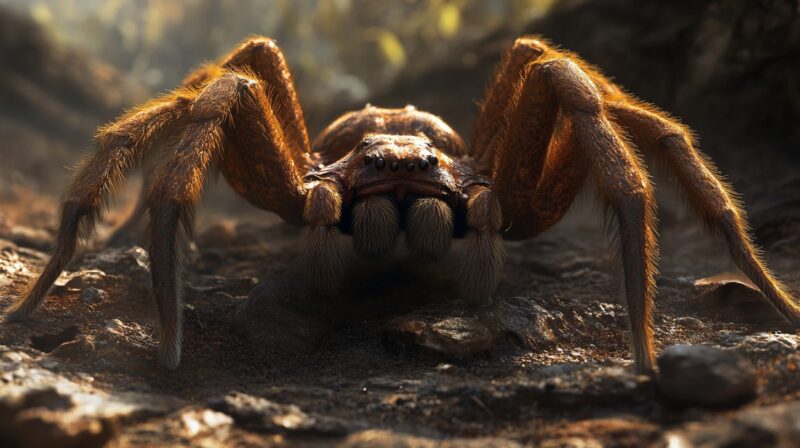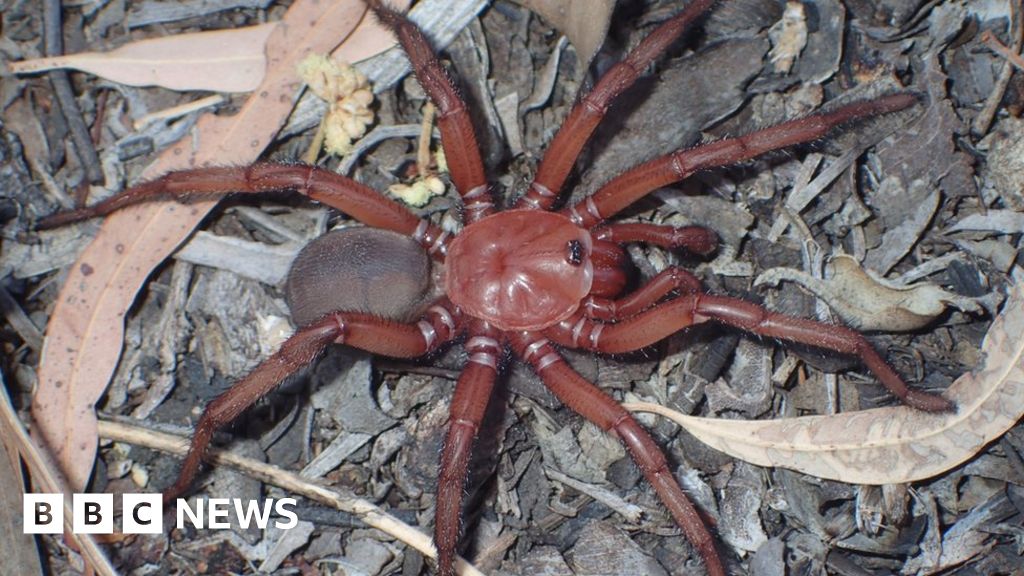The largest spider in the world is the Giant Huntsman, an arachnid that amazes with its size and speed. Known for its sprawling leg span, this spider holds the record as the world’s biggest by size. In this article, we will explore its habitat, diet, behavior, and whether it makes a good pet.
What is the Largest Spider?
The largest spider in the world is the Giant Huntsman Spider (Heteropoda maxima). Found in caves in Laos, this massive arachnid holds the title due to its impressive leg span, which can reach up to 12 inches (30 cm) across. While other spiders, like the Goliath Bird-Eater, might weigh more, the Huntsman claims the record for size, making it the largest spider based on leg span.
The Giant Huntsman spider was discovered relatively recently, in 2001, by German scientist Peter Jäger. Its long legs and speed make it a unique predator, different from many web-building spiders that trap their prey. Instead, this spider relies on its agility to hunt.
Where Does the Giant Huntsman Live?
The Giant Huntsman spider is native to Laos, specifically found in the deep, dark caves of the region. These caves provide the perfect humid and sheltered environment that allows this spider to thrive. Unlike other spiders that make their homes in webs in forests or grasslands, the Giant Huntsman prefers the crevices and hiding spots within caves. The darkness of these environments helps it stay hidden from predators and allows it to hunt at night.
The spider’s natural habitat in Southeast Asia is primarily limestone caves, where its large, spread-out legs give it the ability to move quickly across rocks and surfaces. The environment also provides plenty of food in the form of insects and small invertebrates, which make up most of its diet.
How Big is the Largest Spider?
The Giant Huntsman holds the title of the largest spider due to its leg span, which can grow as wide as 12 inches (30 centimeters). While its body is relatively small in comparison to the Goliath Birdeater, which is heavier, the Huntsman’s sprawling legs give it a significant advantage in claiming the top spot.

Unlike other large spiders, which may rely on weight and bulk, the Giant Huntsman uses its long, slender legs to maneuver quickly across its environment. This allows it to hunt and escape danger much more effectively. The size alone is enough to give anyone a fright, but the spider is more interesting than terrifying when you learn about its unique abilities.
Why is it Called the Huntsman?
The Huntsman spider gets its name because of its hunting behavior. Unlike web-building spiders, the Huntsman does not spin webs to catch its prey. Instead, it actively hunts down insects and other small creatures. This active hunting style, paired with its incredible speed and agility, makes it a formidable predator in its natural habitat.
While many spiders wait for prey to come to them, the Huntsman moves swiftly, using its long legs to ambush and capture its prey before delivering a venomous bite. This hunting method has earned it the “Huntsman” name, emphasizing its role as an active predator.
How Fast Can Huntsman Spiders Run?
One of the most surprising facts about the Huntsman spider is its incredible speed. The Giant Huntsman can run at speeds of up to 3 feet per second. This speed is useful not only for catching prey but also for escaping threats. Its long legs help it move swiftly over various surfaces, allowing it to chase down food or flee from predators.
Do Huntsman Spiders Bite?
While Huntsman spiders do possess venom, they are not particularly dangerous to humans. Their bites can cause mild discomfort, similar to a bee sting, but they are not considered highly venomous or life-threatening. Huntsman spiders typically avoid human contact, preferring to hide or flee rather than bite.
However, if a Huntsman feels threatened, especially when handled or cornered, it might bite in self-defense. The bite is not deadly, but it can cause swelling and mild pain. As with any spider bite, it’s always a good idea to seek medical advice if you’re bitten, but there’s no need for alarm with Huntsman spiders.
How Do Huntsman Spiders Catch Their Prey?
Huntsman spiders, true to their name, are skilled hunters. They do not use webs to trap their prey; instead, they rely on their speed and agility. Huntsman spiders use their long legs to chase down and overpower insects and small animals. Once the prey is caught, the Huntsman spider delivers a venomous bite that paralyzes the prey, making it easier to consume.
Unlike web spinners that are passive in their approach to catching food, the Huntsman is an active predator. This ability to actively hunt makes it quite unique compared to other large spiders that rely on stationary traps.
What Does the Huntsman Spider Eat?
The diet of a Huntsman spider primarily consists of insects, but they are not picky eaters. They will consume any small creature that they can overpower. This includes crickets, beetles, cockroaches, and even other smaller spiders. In the caves of Laos, where the Giant Huntsman resides, their prey consists of insects and small animals that inhabit the cave environment.
While their diet may seem simple, Huntsman spiders play a vital role in controlling insect populations, making them beneficial in many ecosystems. Their ability to catch and consume pests like cockroaches makes them a natural form of pest control in some regions.
Can You Keep a Huntsman as a Pet?
Keeping a Huntsman spider as a pet is possible, though it is not as common as other species of tarantulas or exotic spiders. For people who are interested in keeping a Huntsman, there are a few things to consider.

Huntsman spiders require a large enclosure due to their size and speed. They need space to move around and a well-ventilated environment that mimics their natural habitat. Maintaining a humid environment is essential, as it replicates the spider’s natural cave habitat. Additionally, feeding the Huntsman a diet of live insects like crickets and mealworms is crucial to their well-being.
Are Huntsman Spiders Aggressive?
Despite their large size and hunting behavior, Huntsman spiders are not aggressive toward humans. They are more likely to run and hide than to attack. Their primary focus is on hunting small insects, and they do not pose a significant threat unless they feel cornered. In most cases, Huntsman spiders will flee from humans rather than bite.
How Long Do Huntsman Spiders Live?
The lifespan of a Huntsman spider is relatively short compared to other spiders. On average, they live for about two years. However, in captivity, where food and conditions are optimal, they can sometimes live longer. The Giant Huntsman, like many large spider species, has a slower growth rate, and its size helps it survive longer in the wild than smaller species.
What Makes the Huntsman Spider Different?
Several factors make the Huntsman spider unique, but its most defining characteristic is its size and speed. While other large spiders may rely on webs to catch prey, the Huntsman uses its fast reflexes and long legs to hunt. Its adaptability to different environments, from caves to homes in Southeast Asia, also sets it apart from other species.
Additionally, the Huntsman’s ability to climb smooth surfaces like walls and ceilings, thanks to the sticky hairs on its feet, makes it more mobile than many other spiders. This versatility helps it thrive in various environments.
How Fast Can Huntsman Spiders Run?
As mentioned earlier, Huntsman spiders are incredibly fast and capable of running at speeds of up to 3 feet per second. This speed helps them catch prey and escape predators quickly. Their long legs give them the advantage of agility, allowing them to dart across surfaces with ease. Speed is one of the reasons the Huntsman is such an effective hunter, especially in its cave-dwelling environment.
The Bottom Line
The Giant Huntsman spider holds the title of the largest spider in the world, not just for its leg span but also for its unique hunting style and incredible speed. While its size may seem frightening to some, the Huntsman is a fascinating creature that plays an important role in controlling insect populations. It’s important to remember that despite its size and hunting skills, the Huntsman is not aggressive toward humans and is more likely to run away than attack.
Whether you’re interested in keeping one as a pet or simply curious about its behavior, the Huntsman spider remains one of the most extraordinary and misunderstood creatures in the world of arachnids.



